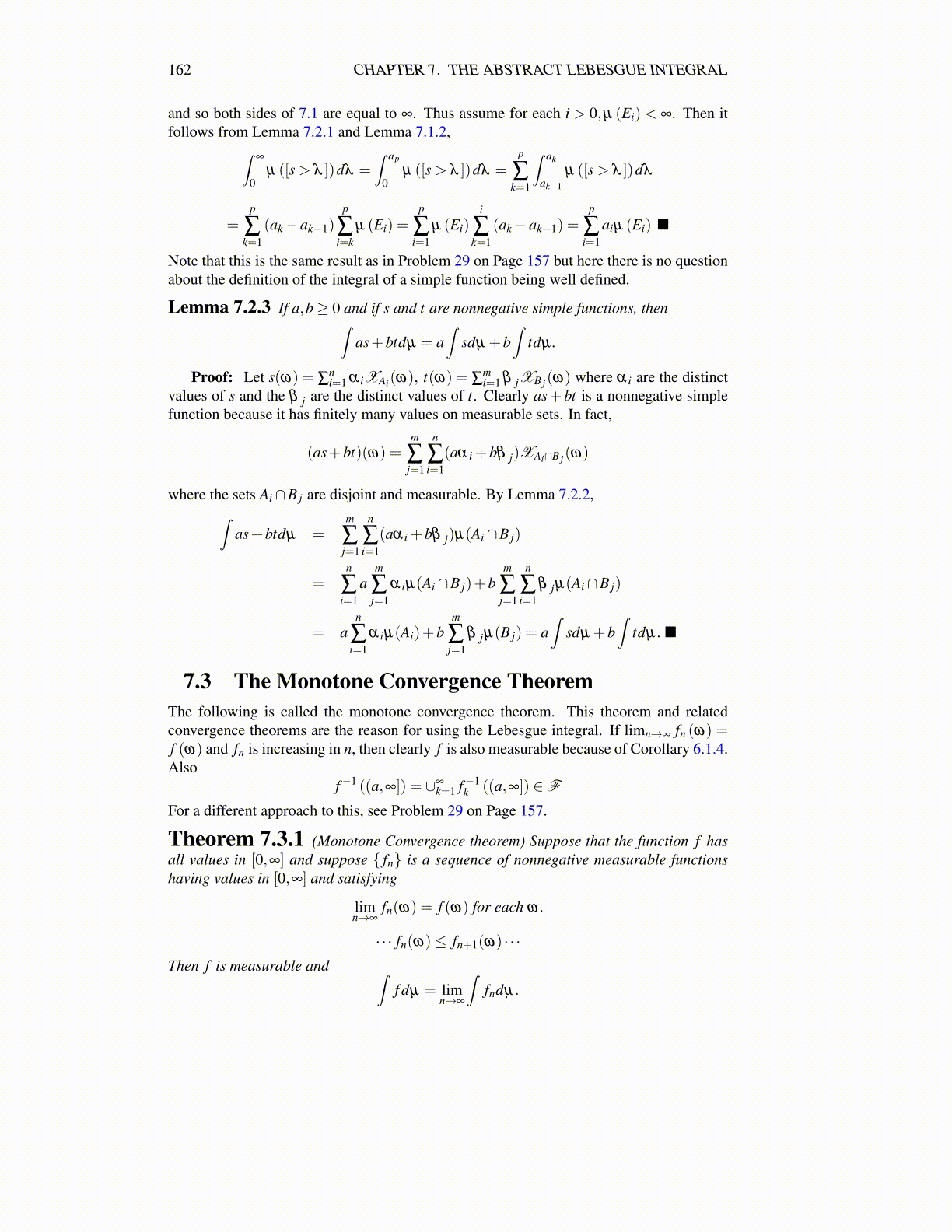
162 CHAPTER 7. THE ABSTRACT LEBESGUE INTEGRAL
and so both sides of 7.1 are equal to ∞. Thus assume for each i > 0,µ (Ei) < ∞. Then itfollows from Lemma 7.2.1 and Lemma 7.1.2,∫
∞
0µ ([s > λ ])dλ =
∫ ap
0µ ([s > λ ])dλ =
p
∑k=1
∫ ak
ak−1
µ ([s > λ ])dλ
=p
∑k=1
(ak−ak−1)p
∑i=k
µ (Ei) =p
∑i=1
µ (Ei)i
∑k=1
(ak−ak−1) =p
∑i=1
aiµ (Ei) ■
Note that this is the same result as in Problem 29 on Page 157 but here there is no questionabout the definition of the integral of a simple function being well defined.
Lemma 7.2.3 If a,b≥ 0 and if s and t are nonnegative simple functions, then∫as+btdµ = a
∫sdµ +b
∫tdµ .
Proof: Let s(ω) = ∑ni=1 α iXAi(ω), t(ω) = ∑
mi=1 β jXB j(ω) where α i are the distinct
values of s and the β j are the distinct values of t. Clearly as+ bt is a nonnegative simplefunction because it has finitely many values on measurable sets. In fact,
(as+bt)(ω) =m
∑j=1
n
∑i=1
(aα i +bβ j)XAi∩B j(ω)
where the sets Ai∩B j are disjoint and measurable. By Lemma 7.2.2,∫as+btdµ =
m
∑j=1
n
∑i=1
(aα i +bβ j)µ(Ai∩B j)
=n
∑i=1
am
∑j=1
α iµ(Ai∩B j)+bm
∑j=1
n
∑i=1
β jµ(Ai∩B j)
= an
∑i=1
α iµ(Ai)+bm
∑j=1
β jµ(B j) = a∫
sdµ +b∫
tdµ . ■
7.3 The Monotone Convergence TheoremThe following is called the monotone convergence theorem. This theorem and relatedconvergence theorems are the reason for using the Lebesgue integral. If limn→∞ fn (ω) =f (ω) and fn is increasing in n, then clearly f is also measurable because of Corollary 6.1.4.Also
f−1 ((a,∞]) = ∪∞k=1 f−1
k ((a,∞]) ∈F
For a different approach to this, see Problem 29 on Page 157.
Theorem 7.3.1 (Monotone Convergence theorem) Suppose that the function f hasall values in [0,∞] and suppose { fn} is a sequence of nonnegative measurable functionshaving values in [0,∞] and satisfying
limn→∞
fn(ω) = f (ω) for each ω.
· · · fn(ω)≤ fn+1(ω) · · ·Then f is measurable and ∫
f dµ = limn→∞
∫fndµ.